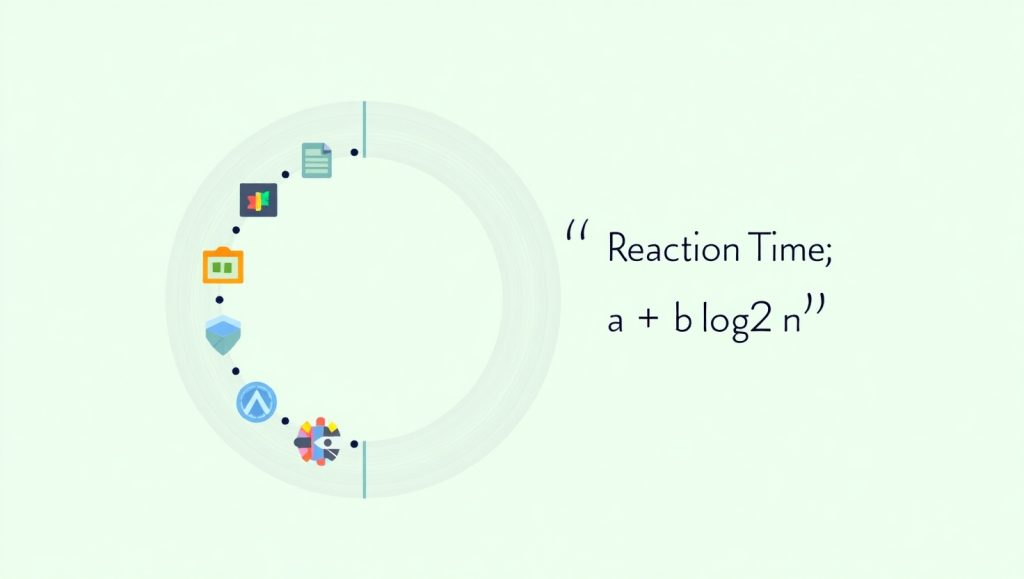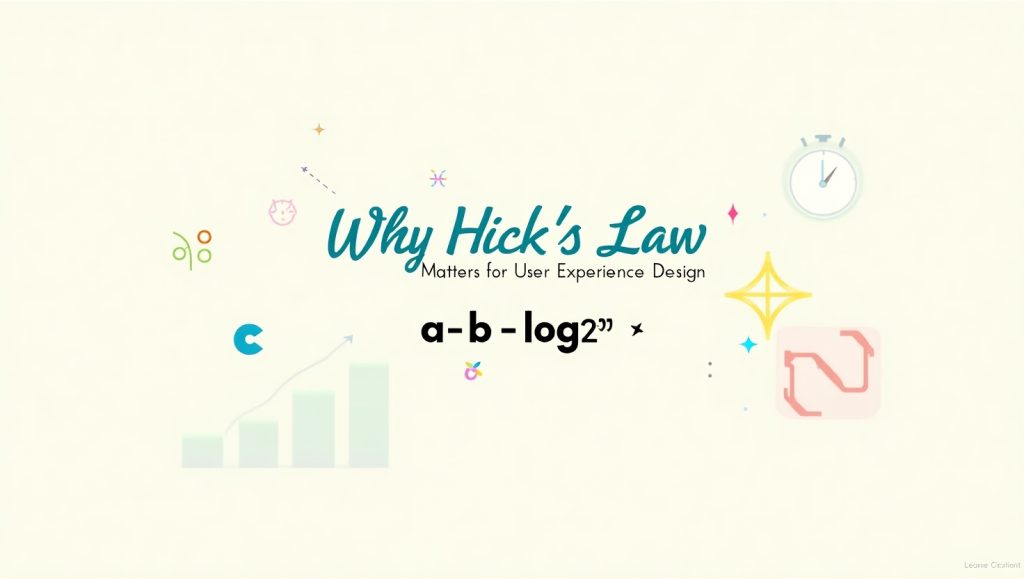Understanding Hick’s Law and Its Core Principles

Hick’s Law is a psychological concept attributed to British psychologists William Edmund Hick and Ray Hyman. According to it, the time required for an individual to make a decision grows with the number and complexity of the available choices. In user experience (UX) design, the principle has deep implications. It implies that reducing choices can result in faster, more enjoyable interactions.
In UX terms, this does not translate to eliminating all possibilities. Rather, it implies designers must prioritize simplicity. When people arrive at a web page or open an app, they don’t want to be hit with an overwhelming number of buttons, links, or dropdowns. Each extra option causes them to stall, process, and decide. That split second? It could be the difference between a conversion and a bounce.
This legislation is particularly pertinent to computer products that demand rapid decisions, including e-commerce, SaaS dashboards, and mobile apps. By segmenting information, reducing options per page, and applying visual hierarchy, designers have the ability to lead users more intuitively.
In addition, Hick’s Law supplements other UX heuristics such as Fitts’s Law and the Gestalt Principles. Whereas Fitts’s Law is concerned with the physical action of tapping or clicking, Hick’s Law is concerned with the cognitive burden of deciding.
If you’ve ever felt overwhelmed navigating a site with 15 different menu options, you’ve experienced Hick’s Law in action. Reducing cognitive load isn’t just about minimalism; it’s about empathy. It’s about understanding how users think and feel. Keeping the interface simple and intuitive ensures users feel in control—and that builds trust.
A classic illustration of Hick’s Law being used correctly can be noticed in businesses providing website design Cardiff services, where user journeys are simplified and options are made intentionally few.
Why Choice Overload Destroys User Engagement
Choice overload occurs when users are presented with too many options, leading to decision fatigue. Hick’s Law directly addresses this issue by encouraging simplification. Let’s dive into how reducing options improves engagement.
When confronted with too many choices, people tend to get anxious. Whether deciding on a pricing plan, picking a variant of a product, or getting through a feature-laden dashboard, too many options freeze the ability to act. That’s not theory; it’s a widely documented pattern of behavior.
Netflix is a good example. Although having a vast collection, the interface shows content ordered by relevance, popular titles, or category. That way, the users are not scrolling endlessly. Likewise, Amazon fine-tunes search results by using filters and categories, leading users through high numbers of content without inundating them.
Web interfaces must apply Hick’s Law to guide users subtly. Make main actions clear, secondary choices hidden in menus or toggles. Allow users to concentrate on one thing at a time. For example, a sign-up process can have only one call-to-action button such as “Get Started,” instead of overwhelming users with several next steps.
A clear, well-designed path also instills confidence. When users don’t need to overthink every move, they’re more likely to get the job done, whether it’s a checkout process or a form fill. Simple is trustworthy.
Designers who apply Hick’s Law minimize user friction, driving satisfaction and conversions. This is especially crucial in high-competition industries such as SaaS and e-commerce. In short, simplicity isn’t only beautiful; it’s functional.
Hick’s Law in Navigation and Information Architecture

Navigation design is where Hick’s Law is most useful. Whether a website menu, app tab bar, or mega dropdown, each additional item adds decision time. Well-designed UX navigation enables users to find what they want quickly—without overwhelming them with choices.
The secret is to put content first. What do visitors most want when they arrive at your site? What’s most important to keep them interested? Heatmaps and analytics can provide the answers.
Progressive disclosure is one of the approaches. You display a few key items and allow users to dig deeper only on their own will. A primary example is a main menu that displays four top-level links: Home, Services, About, and Contact. A hover or click on one discloses submenus with more options. This allows users to begin with a reasonable set of choices and get more only when necessary.
Clustering similar things together also facilitates navigation. When you provide various services, lump them under one menu item and not list every single one. Employ headers, icons, and whitespace to perceptually distinguish from one another. This makes it a neater, more relaxing interface.
Consistent behavior between devices is important too. On mobile, do not pack every menu item onto one screen. Use collapsible groups and icons for simplicity instead. A decent responsive design follows Hick’s Law and provides the same intuitive feel between devices.
Designers using these methods usually notice improved user retention and fewer bounces. A simple-to-use menu tends to be the initial indication that a user realizes they’re in capable hands.
Emotional Impact: Making Users Feel Confident and in Control
Beyond logic, Hick’s Law speaks to user emotion. When choices are easy to understand, users feel confident. When they’re overwhelmed, they feel lost, anxious, or even frustrated. That emotional experience is critical in UX design.
We often underestimate how much emotion influences digital interaction. Think about apps that feel intuitive. You never pause to think about where to tap next. You glide through them. That feeling of control breeds satisfaction.
On the flip side, interfaces that throw too many choices at you can make you feel inadequate—like you’re not tech-savvy enough. It’s not the user’s fault. It’s a design flaw.
Simplicity also evokes trust. When a user sees a clean, easy-to-understand interface, it signals that the business knows what it’s doing. That trust carries over into conversions, purchases, and brand loyalty. Hick’s Law isn’t about dumbing things down; it’s about being emotionally intelligent.
That’s why emotionally aware UX writing matters too. Labels like “Let’s Go” instead of “Submit,” or tooltips that gently guide instead of instruct can make users feel cared for. Combine that with a choice-reducing layout, and you’ve got a winning formula.
Ultimately, it’s about empathy. You’re designing for humans with short attention spans, busy lives, and emotional reactions. Make them feel smart, not stressed. Let them breeze through your interface. Because when users feel good, they stick around.
Balancing Minimalism and Functionality
Here’s where Hick’s Law becomes problematic. Over-simplification can be bad too. Take away too many options, and you risk restricting functionality or annoying power users. You don’t want to just simplify—you want to simplify wisely.
You would like to expose the most applicable actions without sacrificing access to more sophisticated features. One strategy is to rank alternatives by context of the user. For instance, a photo editing application could expose primary tools first with more sophisticated features hidden behind an “Advanced” menu.
Another method is personalization. Reveal users their most commonly used choices. Spotify accomplishes this effectively by revealing recently used or often used playlists. It’s Hick’s Law in practice, tailored.
For B2B dashboards or data-driven interfaces, Hick’s Law can walk users through step by step. Employ onboarding tours, tooltips, and contextual hints to unveil complexity when necessary. Keep the experience linear initially, branching out later.
Minimalism must never compromise on capability. The true trick is structuring for simplicity without compromising depth. When you do it correctly, users never even realize the complexity lurking beneath your careful design.
Therefore, balance is what matters. Let Hick’s Law be your compass, but never your constraint. Begin simple, then carefully expand. That is how you design interfaces that expand with your users, not apart from them.
conclusion
Hick’s Law is not just a UX buzzword—it’s a strong reminder to design with purpose. Each button, menu item, and call-to-action must have a purpose. By honoring your users’ time and mental resources, you build interfaces that feel effortless to use.
From navigation and onboarding to forms and content layout, this rule can simplify all aspects of the user journey. Less distraction is greater conversion. More obvious paths equal happier users.